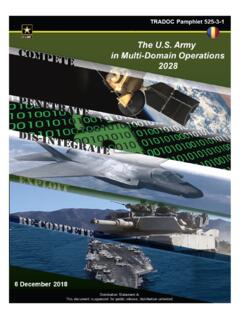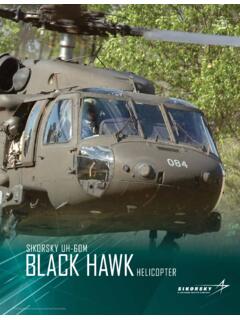Transcription of China Naval Modernization Implications for U.S. Navy ...
1 China Naval Modernization : Implications for Navy Capabilities Background and Issues for Congress Updated December 2, 2021 Congressional Research Service RL33153 China Naval Modernization : Implications for Navy Capabilities Congressional Research Service Summary In an era of renewed great power competition, China s military Modernization effort, including its Naval Modernization effort, has become the top focus of defense planning and budgeting. China s navy, which China has been steadily modernizing for more than 25 years, since the early to mid-1990s, has become a formidable military force within China s near-seas region, and it is conducting a growing number of operations in more-distant waters, including the broader waters of the Western Pacific, the Indian Ocean, and waters around Europe.
2 China s navy is viewed as posing a major challenge to the Navy s ability to achieve and maintain wartime control of blue-water ocean areas in the Western Pacific the first such challenge the Navy has faced since the end of the Cold War. China s navy forms a key element of a Chinese challenge to the long-standing status of the United States as the leading military power in the Western Pacific. Some observers are expressing concern or alarm regarding the pace of China s Naval shipbuilding effort and resulting trend lines regarding the relative sizes and capabilities of China s navy and the Navy. China s Naval Modernization effort encompasses a wide array of ship, aircraft, and weapon acquisition programs, as well as improvements in maintenance and logistics, doctrine, personnel quality, education and training, and exercises.
3 China s navy has currently has certain limitations and weaknesses, and is working to overcome them. China s military Modernization effort, including its Naval Modernization effort, is assessed as being aimed at developing capabilities for addressing the situation with Taiwan militarily, if need be; for achieving a greater degree of control or domination over China s near-seas region, particularly the South China Sea; for enforcing China s view that it has the right to regulate foreign military activities in its 200-mile maritime exclusive economic zone (EEZ); for defending China s commercial sea lines of communication (SLOCs), particularly those linking China to the Persian Gulf; for displacing influence in the Western Pacific; and for asserting China s status as the leading regional power and a major world power.
4 Consistent with these goals, observers believe China wants its navy to be capable of acting as part of a Chinese anti-access/area-denial (A2/AD) force a force that can deter intervention in a conflict in China s near-seas region over Taiwan or some other issue, or failing that, delay the arrival or reduce the effectiveness of intervening forces. Additional missions for China s navy include conducting maritime security (including antipiracy) operations, evacuating Chinese nationals from foreign countries when necessary, and conducting humanitarian assistance/disaster response (HA/DR) operations. The Navy in recent years has taken a number of actions to counter China s Naval Modernization effort. Among other things, the Navy has shifted a greater percentage of its fleet to the Pacific; assigned its most-capable new ships and aircraft and its best personnel to the Pacific; maintained or increased general presence operations, training and developmental exercises, and engagement and cooperation with allied and other navies in the Indo-Pacific; increased the planned future size of the Navy; initiated, increased, or accelerated numerous programs for developing new military technologies and acquiring new ships, aircraft, unmanned vehicles, and weapons; begun development of new operational concepts ( , new ways to employ Navy and Marine Corps forces) for countering Chinese maritime A2/AD forces.
5 And signaled that the Navy in coming years will shift to a more-distributed fleet architecture that will feature a smaller portion of larger ships, a larger portion of smaller ships, and a substantially greater use of unmanned vehicles. The issue for Congress is whether the Navy is responding appropriately to China s Naval Modernization Naval Modernization : Implications for Navy Capabilities Congressional Research Service Contents Introduction .. 1 Issue for Congress .. 1 Sources and Terminology .. 1 Background .. 2 Brief Overview of China s Naval Modernization Effort .. 2 Numbers of Ships; Comparisons to Navy .. 5 Overview .. 5 Ultimate Size and Composition of China s Navy Not Publicly Known .. 6 Number of Ships Is a One-Dimensional Measure, but Trends in Numbers Can Be of Value Analytically.
6 6 Three Tables Showing Numbers of Chinese and Navy Ships .. 6 Selected Elements of China s Naval Modernization Effort .. 10 Anti-Ship Missiles .. 11 Submarines .. 14 Aircraft Carriers .. 17 Surface Combatants .. 23 Amphibious Ships .. 28 Operations Away from Home Waters .. 33 Navy Response .. 34 Overview .. 34 Cooperation with Naval Forces of Allies and Other Countries .. 34 Size of Navy, Fleet Architecture, and Operational Concepts .. 36 Programs for Acquiring Highly Capable Ships, Aircraft, and Weapons .. 38 Issues for Congress .. 38 Overview .. 38 Discussion .. 39 Legislative Activity for FY2022 .. 43 Coverage in Related CRS Reports .. 43 FY2022 National Defense Authorization Act ( 4350/S. 2792) .. 44 House .. 44 Senate .. 45 Figures Figure 1. DF-21D Anti-Ship Ballistic Missile (ASBM).
7 11 Figure 2. DF-26 Multi-Role Intermediate-Range Ballistic Missile (IRBM) .. 11 Figure 3. Reported Image of Anti-Ship Cruise Missile (ASCM) .. 12 Figure 4. Reported Image of Anti-Ship Cruise Missile (ASCM) .. 13 Figure 5. Reported Image of Anti-Ship Cruise Missile (ASCM) .. 13 Figure 6. Yuan (Type 039) Attack Submarine (SS) .. 15 Figure 7. Shang (Type 093) Attack Submarine (SSN) .. 15 Figure 8. Jin (Type 094) Ballistic Missile Submarine (SSBN) .. 16 Figure 9. Liaoning (Type 001) Aircraft Carrier .. 18 Figure 10. Shandong (Type 002) Aircraft Carrier .. 19 China Naval Modernization : Implications for Navy Capabilities Congressional Research Service Figure 11. Type 003 Aircraft Carrier Under Construction .. 20 Figure 12. J-15 Flying Shark Carrier-Capable Fighter .. 22 Figure 13.
8 Renhai (Type 055) Cruiser (or Large Destroyer) .. 24 Figure 14. Renhai (Type 055) Cruiser (or Large Destroyer) .. 25 Figure 15. Luyang III (Type 052D) Destroyer .. 26 Figure 16. Jiangkai II (Type 054A) Frigate .. 27 Figure 17. Jingdao (Type 056) Corvette .. 28 Figure 18. Yuzhao (Type 071) Amphibious Ship .. 29 Figure 19. Type 075 Amphibious Assault Ship .. 30 Figure 20. Type 075 Amphibious Assault Ship .. 31 Figure 21. Notional Rendering of Possible Type 076 Amphibious Assault Ship .. 32 Figure 22. Notional Rendering of Possible Type 076 Amphibious Assault Ship .. 32 Tables Table 1. Numbers of Certain Types of Chinese and Ships Since 2005 .. 7 Table 2. Numbers of Chinese and Navy Battle Force Ships, 2000-2030 .. 9 Table 3. Numbers of Chinese and Navy Ships, 2020-2040.
9 10 Appendixes Appendix A. Comparing and Chinese Numbers of Ships and Naval Capabilities .. 47 Appendix B. Navy s Ability to Counter Chinese ASBMs .. 49 Contacts Author Information .. 54 China Naval Modernization : Implications for Navy Capabilities Congressional Research Service 1 Introduction Issue for Congress This report provides background information and issues for Congress on China s Naval Modernization effort and its Implications for Navy capabilities. In an era of renewed great power competition,1 China s military Modernization effort, including its Naval Modernization effort, has become the top focus of defense planning and The issue for Congress for this CRS report is whether the Navy is responding appropriately to China s Naval Modernization effort.
10 Decisions that Congress reaches on this issue could affect and allied security, Navy capabilities and funding requirements, and the defense industrial base. Another CRS report provides an overview of China s military in Sources and Terminology This report is based on unclassified open-source information, such as the annual Department of Defense (DOD) report to Congress on military and security developments involving China ,4 a 2019 Defense Intelligence Agency (DIA) report on China s military power,5 a 2015 Office of Naval Intelligence (ONI) report on China s navy,6 published reference sources such as IHS Jane s Fighting Ships,7 and press reports. For convenience, this report uses the term China s Naval Modernization effort to refer to the Modernization not only of China s navy, but also of Chinese military forces outside China s navy that can be used to counter Naval forces operating in the Western Pacific, such as land-based anti-ship ballistic missiles (ASBMs), land-based surface-to-air missiles (SAMs), land-based Air Force aircraft armed with anti-ship cruise missiles (ASCMs), and land-based long-range radars for detecting and tracking ships at sea.















